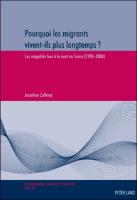Pourquoi les migrants vivent-ils plus longtemps ?
Les inégalités face à la mort en Suisse (1990–2008)
Abstract
Dans les sociétés postindustrielles contemporaines, les migrants ont généralement des risques de décès inférieurs aux populations des pays d’accueil bien qu’ils soient tendanciellement plus vulnérables en raison de moindres capitaux humains, sociaux et économiques. Il s’agit là d’un véritable paradoxe épidémiologique car ces facteurs sont considérés comme les causes fondamentales des inégalités de longévité. A travers le prisme de la société suisse, cette thèse présente les dernières tendances en termes de mortalité différentielle entre les populations suisse et étrangères. Par une vision globale et compréhensive, nous mettons en exergue les particularités des populations migrantes afin d’offrir des clés d’interprétation à ce fameux paradoxe. L’étude tente d’approcher la migration dans toute sa profondeur en investiguant les différentiels en fonction de l’origine et du statut migratoire. En partant des outils de la démographie classique, en passant par des modèles de régression et des arbres d’induction, pour finir par des modèles multiniveaux exprimant des risques spatiaux, la connaissance des processus et des populations s’affermit. Au terme de ce manuscrit, nous aboutissons à une synthèse sur les principaux mécanismes explicatifs. La discussion reviendra sur deux axes clés qui expriment, selon nous, l’essentiel de l’avantage observé : des biais de sélection à l’entrée et à la sortie ainsi qu’une « culture de la migration ».
Keywords
Population and demography; Urban communitiesDOI
10.3726/b10891Publisher website
https://www.peterlang.com/Publication date and place
Bern, 2017Series
Population, Famille et Société / Population, Family, and Society, 24Classification
Population and demography


 Download
Download